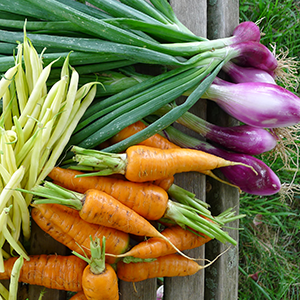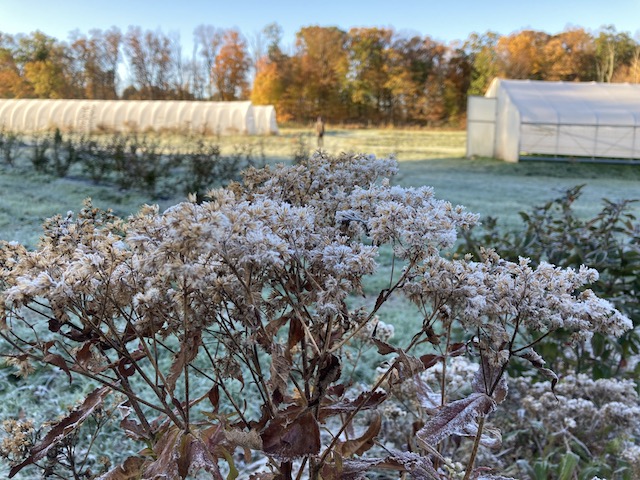









News and Notes | The Anchor Run Blog
Displaying a Single Post |
Show Recent Posts
November 7, 2021
Good Food Around the Bend
by Farmer Derek
Good Food Around the Bend
by Farmer Derek

Frost hairs covered nearly everything on the farm 5 mornings in a row last week with temperatures bottoming out in the mid-20s.
Well that seemingly came out of nowhere! From no frosts to 5 consecutive frozen mornings just like that. Thankfully the crops we grow this time of year are hardy enough to tolerate this wild swing (sadly except for the lingering peppers). We hope for a slow transition to cold temperatures but this time around we bypassed the 30s and went right into the 20s. Praise be to the plants for getting through it unscathed. Since the original lows were forecast only for the low 30s we didn't take any extra precautions except for lowering the sides of the tunnels a bit but not all the way. I was surprised that first morning when the temperature obviously went much lower than the forecast 33 and woke up to a blanket of heavy frost and mildly frozen plants even in the tunnels. Just having that roof over their heads though keeps the frost from settling on top of the crops and burning the leaves, blemishing them and eventually causing that dead tissue to deteriorate. But by leaving the doors open and sides slightly up, enough subfreezing air crept in anyway giving them a good taste and wake up call for late fall and winter weather. If anything, it should help slow the growth of some of the tunnel crops that were speedily reaching for the sun during this overall balmy fall.
While mornings were too cold to comfortably do much outside and fields remained moist I spent a lot of time preparing plans and making purchases for next growing season. I like to do a lot of the crop planning early in the slower season while everything is still relatively fresh in my mind. I also reworked the spreadsheets for our seed information, greenhouse seeding, transplanting, and crop rotation bed feet data into one spreadsheet so I can basically update all of that simultaneously which will greatly expedite the process and limit my computer staring. It's also sort of necessary because I need to know how much of a crop and variety we're growing so I can most accurately order the correct number of seeds because we don't like to save seeds from one season to the next due to their sometimes unpredictable loss of viability. I do really enjoy planning the growing season from the comforts of a warm house with some good music going. Because we mostly grow annual crops we start fresh each year with expectations of perfection.
To hope for the best crops the following year we need to collect and record whatever data we can use to make good decisions and plan. Most of it begins with soil health, our number one resource. We collect soil samples in the early fall and send them to the lab for analysis. The results drive our inputs, highlighting mineral concentrations, organic matter, pH, etc. We couple the results with perceived health of cash crops and cover crops. Since our soils here have been managed organically for almost 20 years and we have tests going back that far, taken every three years, we have a good idea of the direction our farm management is going. Suffice it to say, our soils are in really good shape and we mostly just need to apply maintenance amounts of compost, fertilizers, and amendments. But because it's not only overall amounts but also ratios of the minerals, minor tweaking does take place here and there. For example, based on the this year's soil test, one of our fields is deficient in potassium relative to others and the organic fertilizer we'll add there next year will have more of that than say phosphorous. It's all a work in progress, but the goal is sustainability and regeneration.
Thank you for your support!

POSTS BY TYPE
POSTS BY MONTH

